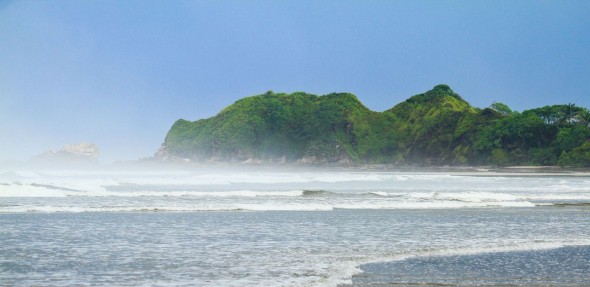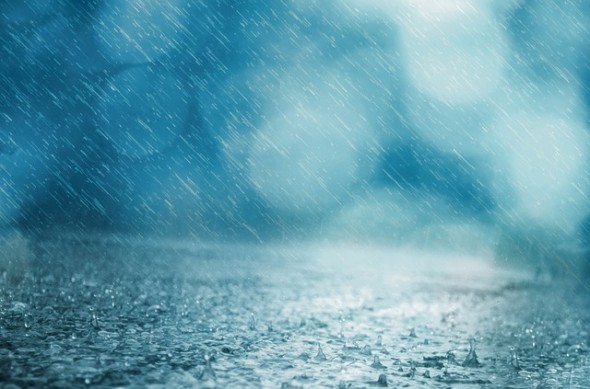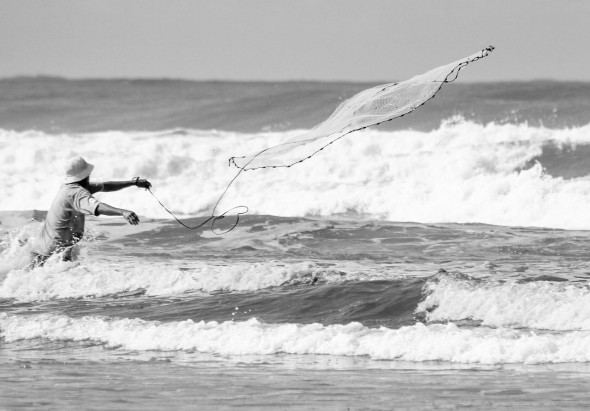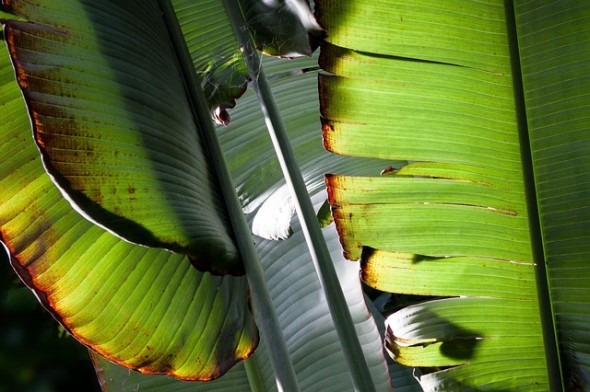Blog

Joaquín Gutiérrez is the author of Cocorí, Puerto Limón, Manglar, and Murámonos, Federico, which earned him the Premio Nacional Aquileo J. Echevvería in 1973. He writes short stories, novels, poems, and journalistic articles. His short story in Costa Rica: A Traveler’s Literary Companion, “A Leaf of Air,” is the longest in the collection, though the prose and storyline are so strong that the reader craves more.
The story follows the speaker who, as a child, meets Theresa, a young girl with whom whom he falls in love, and who gives him a big, glossy leaf:
“This is an hoja de aire, a leaf of air,” she said as she gave it to me. “Hang it by a thread where there is a wind and watch the tiny breezes being born.”
Though the speaker lives many years away from his homeland, he often thinks of Theresa and the leaf of air she gave to him. “And don’t come telling me that my leaf of air is only a symbol and that symbols don’t correspond to any physical reality,” Gutiérrez writes in the speaker’s voice, later in life. But the reader must delve into the speaker’s interactions with Theresa throughout the story to determine what this symbolism means.
Photo Credit: Jon Sullivan / Public Domain
Source: Ras, Barbara, ed. Costa Rica: A Traveler’s Literary Companion. San Francisco: Whereabouts, 1994.
Nov 12, 2014 | Categories: Random | Comments Off on Joaquín Gutiérrez
 Creating an eco friendly Thanksgiving is not as hard as you might think—it just means asking a few questions that might slightly shift your traditions. Do you typically buy a cut flower arrangement for the table? Look for organic flowers or a beautiful living succulent arrangement. Is turkey your main course? Find a free range, organic, heritage bird—and add vegetarian and vegan side dishes that can combine to become a main course. You can even shop your local farmer’s market for your feast, and find recycled elements for your holiday decor. Happy turkey day!
Creating an eco friendly Thanksgiving is not as hard as you might think—it just means asking a few questions that might slightly shift your traditions. Do you typically buy a cut flower arrangement for the table? Look for organic flowers or a beautiful living succulent arrangement. Is turkey your main course? Find a free range, organic, heritage bird—and add vegetarian and vegan side dishes that can combine to become a main course. You can even shop your local farmer’s market for your feast, and find recycled elements for your holiday decor. Happy turkey day!
Nov 10, 2014 | Categories: Sustainability | Tags: cooking, food, free range, holiday, organic, thanksgiving, turkey, turkey day | Comments Off on Ecofy Your Thanksgiving

The long months of rainy season transform the Pelada headland from dusty brown to verdant green, no doubt invoking the mindset of those ship-bound Westerners who first laid eyes upon the already Indigenously peopled coast: Costa Rica ! What else could have come to mind?
Soon, the rain and mostly onshore wind will yield to clear, dry air, and offshore winds…
photo provided by Surfing Nosara
Nov 07, 2014 | Categories: Costa Rica, Creative Culture, Harmony Hotel, Nosara, Surfing | Comments Off on Guiones Surf Photo of the Week

Mario González Feo, reporter and columnist, is the author of Nihil, Nihil II, and María de la soledad. His story “Bucho Vargas, Healer and Medicine Man” is the recollection of the speaker, who, as a child, witnessed the arrival of a medicine man.
Bucho Vargas arrived “carrying an immense umbrella, since it was raining…He had a pleasant laugh, ready and contagious, not at all the laugh of a simpleton. With natural grace and a good deal of ingenuity, he was the first to celebrate his every word.” Bucho Vargas visits the home of the speaker to care for a very pretty girl named Challa who suffers from an unrelenting attack of boils on her skin. Perhaps it is because Vargas arrives with the rain that he uses the rain to cure Challa of her ailments. Regardless, he leaves his mark on the speaker.
Photo Credit: Pixabay / CC0 Public Domain
Source: Ras, Barbara, ed. Costa Rica: A Traveler’s Literary Companion. San Francisco: Whereabouts, 1994.
Nov 05, 2014 | Categories: Random | Comments Off on Mario González Feo
 You already know about avoiding antibacterial soaps and sanitizers made with triclosan, right? The chemical—a pesticide, natch—breeds antibiotic-resistant bacteria, compromises our immune systems, and is no better than plain old soap-and-water at killing bacteria.
You already know about avoiding antibacterial soaps and sanitizers made with triclosan, right? The chemical—a pesticide, natch—breeds antibiotic-resistant bacteria, compromises our immune systems, and is no better than plain old soap-and-water at killing bacteria.
Yet despite the fact that triclosan is currently under safety review at the FDA and was banned in Minnesota this May, one company is still putting it in your mouth. Colgate’s bestselling Total is currently the only toothpaste on the market that still contains triclosan. Talk about yuck mouth.
Nov 03, 2014 | Categories: Sustainability | Tags: antibacterial, colgate, dental care, oral care, toothpaste, total, triclosan | Comments Off on Nix Triclosan in Toothpaste

We’re not always trying to catch only waves in the surf zone, the ordered chaos of tumbling rollers rushing toward shore. It is a cauldron of energy, boiling with nutrients and marine life. Here, the work of throwing the cast net becomes Art. For the net to elegantly “spread” when thrown, it must first be bundled and folded with great care, much like the packing of a parachute. Then, once surface texture on the water betrays the small fish’s location, the thrower must execute with just the right combination of wrist, arm and waist- rotating- to place the blooming net, as it opens and lands, atop the unsuspecting school. Weights woven into the net’s perimeter provide not only the momentum for “the throw”, but also the means by which the net rapidly sinks, pinning the fish under its descending umbrella. The retrieving line doubles as a cinch chord, closing the umbrella tightly at the base so the fish do not escape.
This fishing method is most often used for “bait”, purposed for catching larger fish. But it is ideal also for simply catching and eating the smaller baitfish themselves for food. We now know that eating lower down on the food chain (think anchovies and sardines) is generally better for the overall ecosystem, leaving progenitors and apex predators to fulfill their valuable roles and reproduce.
The cast net, unlike gill nets and purse seines, is not an indiscriminate killer. After each throw the fisher can inventory what has been caught and quickly put back in the water what is not desired, the organisms known as “by-catch”. This by-catch can be released unharmed, thereby making cast netting a highly specific fishing method void of high incidental kills.
As with Surfing, still photography doesn’t always do it justice. Cast Netting is Poetry in Motion.
photo provided by Surfing Nosara
Oct 31, 2014 | Categories: Costa Rica, Creative Culture, Harmony Hotel, Nature, Nosara, Surfing, Sustainability | Comments Off on Guiones Surf Photo of the Week

Carlos Luis Fallas is the author of Mamita Yunai, Gentes y gentecillas, and Mi Madrina and the winner of the Premio Nacional de Cultura Magón in 1965, the year of his passing. Fallas, who worked on the United Fruit Company’s banana plantations and organized workers there, is known for his championing of the working class. This principle comes through in “In the Shadow of the Banana Tree,” the story featured in Costa Rica: A Traveler’s Literary Companion.
“In the Shadow of the Banana Tree” is an excerpt from Mamita Yunai, and as such, the story does not follow a strict plot, but rather provides color and life to the speaker, his friends Herminio and Calero, the Nicaraguan foreman, Pancho, and the others who join Pancho’s work crew to “open a great swath through the mountains” to carry a train loaded with bananas.
From waking up while still dark and eating rice, beans, and bananas served by Pancho’s wife, to trudging through the forest for a day filled with manual labor and then going to the river to catch machacas and bobos, Fallas details the everyday joys and drudgeries of this cheerful working group.
Photo Credit: Pixabay / CC0 Public Domain
Source: Ras, Barbara, ed. Costa Rica: A Traveler’s Literary Companion. San Francisco: Whereabouts, 1994.
Oct 29, 2014 | Categories: Random | Comments Off on Carlos Luis Fallas
 Volatile organic compounds, or VOCs, are widely used as ingredients in household products. Products release VOCs into the environment, where they can damage soil and groundwater. Vapors of VOCs escaping into the air contribute to air pollution, are potentially carcinogenic and lead to stratospheric ozone depletion, i.e. the Greenhouse Effect.
Volatile organic compounds, or VOCs, are widely used as ingredients in household products. Products release VOCs into the environment, where they can damage soil and groundwater. Vapors of VOCs escaping into the air contribute to air pollution, are potentially carcinogenic and lead to stratospheric ozone depletion, i.e. the Greenhouse Effect.
Luckily, “zero VOC” products are now easy to find: Most major paint and varnish lines now have low or no VOC versions of their most popular shades. If you can’t afford environmentally friendly furniture, try buying second-hand gear. Over time, most VOCs are released—“off-gassed”—into the environment to a point where they’re not as dangerous.
Oct 27, 2014 | Categories: Sustainability | Tags: furniture, off gassing, paint, varnish, voc, volatile organic compounds | Comments Off on Avoid VOCs










